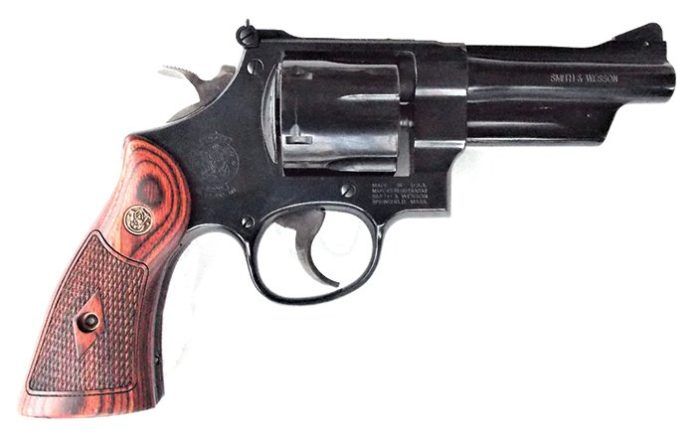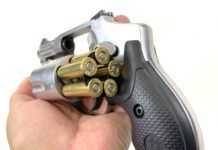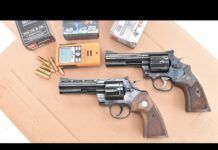The 357 Magnum revolver was introduced in 1935, first chambered in a big-frame revolver. When the handgun was introduced, it cost about $65. Yes, that’s cheap at first glance, but a new car was less than a thousand dollars, and a good-quality 38 Special, 1911, or single-action revolver was available for $35. The Magnum offered sensational performance with twice the energy of the 38 Special. Penetration gave lawmen a handgun that would penetrate vehicles, and outdoorsmen had a handgun that would kill large game with a single shot. Perhaps some of the game taken with the Magnum was a bit of a stunt, but then a good shot may work wonders with a deep-penetrating bullet. Eventually, the 357 Magnum was chambered in lighter revolvers, including the Smith & Wesson Model 19 Combat Magnum. This revolver is basically a 38 Special with a lengthened and heat-treated cylinder. All 357 Magnums have the option of using 38 Special ammunition for training and practice. The consensus was that a K-frame revolver should be fired with twenty 38s for every Magnum cartridge. Small-frame revolvers do not crack frames, but they do crack forcing cones and small parts take a beating. For heavy use, a larger-frame revolver, like those tested here is preferred.
We tested three revolvers from Smith & Wesson and Taurus with slightly different configurations, but all with 4-inch barrels. They were the:
- Smith & Wesson Classic Model 27 150339, an N-frame six shooter, the
- Taurus Model 66 2-660041 K-frame, a seven shooter, and the
- Taurus Model 608 2-608049, a big-frame stainless eight shooter.
Over time, the 357 Magnum has gone from an expensive specialist’s revolver to everyman’s magnum, and there’s a range of choices to pick from in materials, barrel length, sights, and other options. These big-frame revolvers take a beating and keep going, but are sometimes slower from the holster and not as fast to get on target. But because of their weight and frame size, they are usually controllable in rapid fire. The new design large-frame revolvers also may be chambered for seven or eight magnums, and there is also a wider range of choices in handgun grips. Here’s how we thought these particular wheelguns fared when fired side by side at the range:
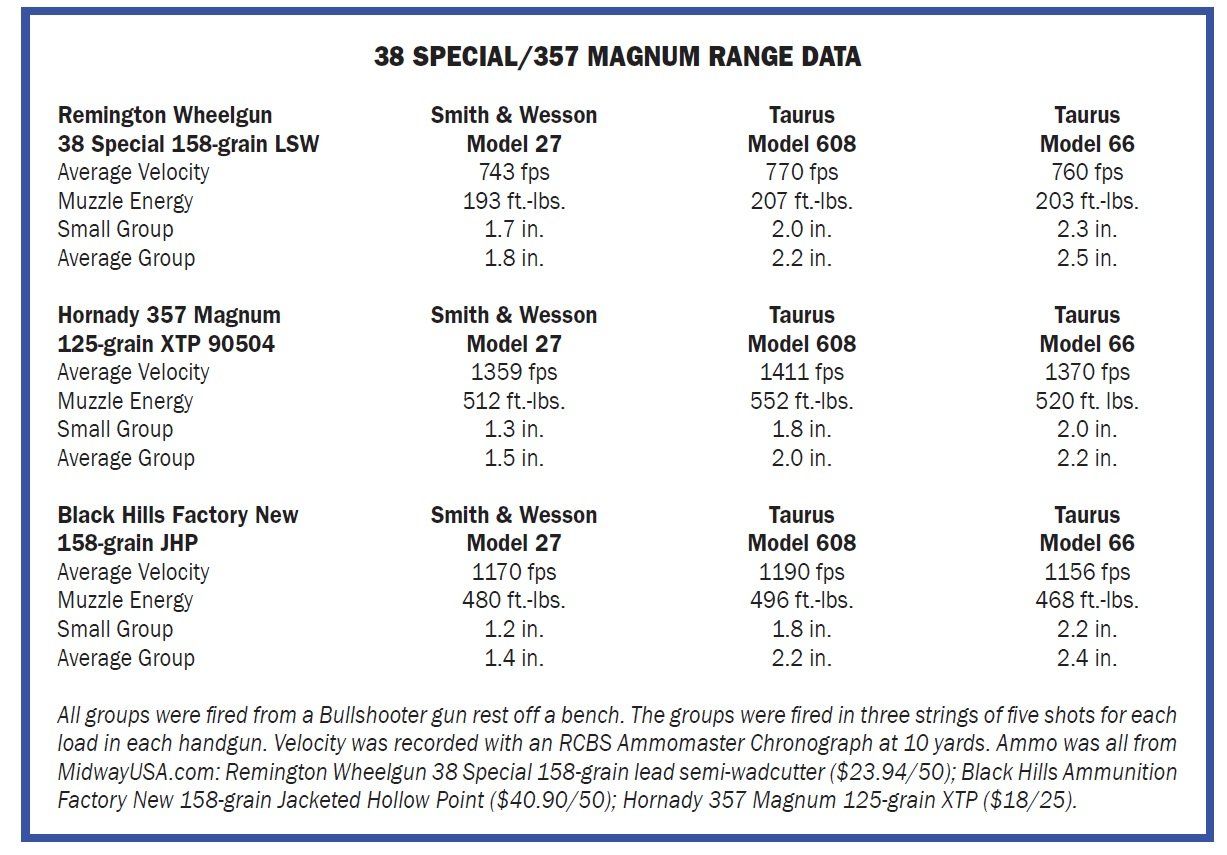
Smith & Wesson Model 27 Classic 150339 38 Special/357 Magnum, $909
GUN TESTS GRADE: B-
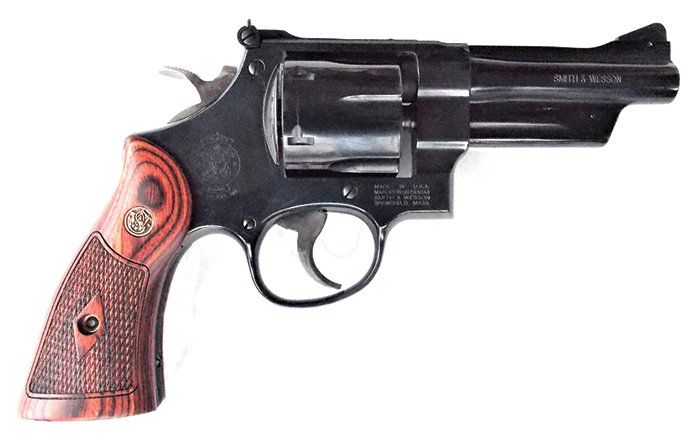
The fit and finish of this handgun are flawless. Accuracy from the benchrest was very good. The grips are very attractive, but they are not the best design for handling magnum loads and during double-action fire. The trigger action was the big problem, very heavy.
Action |
Single/Double Action |
Overall Length |
9.3 in. |
Overall Height |
5.5 in. |
Maximum Width (Cylinder) |
1.7 in. |
Weight Unloaded |
41.0 oz. |
Weight Loaded |
44.0 oz. |
Barrel |
4.0 in. long, blue carbon steel |
Capacity |
6 |
Frame |
Blue carbon steel, large frame |
Cylinder |
Blue carbon steel, fluted |
Front Strap Height |
2.5 in. |
Rear Strap Height |
3.8 in. |
Grips |
Checkered wood |
Grip Thickness (Max) |
1.0 in. |
Grip Circumference (Max) |
5.0 in. |
Front Sight |
Pinned Serrated Ramp |
Rear Sight |
Adjustable |
Sight Radius |
5.7 in. |
Trigger Pull Weight Double Action |
16.0 lbs. |
Trigger Pull Weight Single Action |
6.0 lbs. |
Trigger Span Single Action |
3.0 in. |
Trigger Span Double Action |
3.5 in. |
Safety |
None |
Warranty |
Lifetime |
Telephone |
(800) 331-0852 |
Website |
Smith-Wesson.com |
Made In |
USA |
This was our price at BudsGunShop.com. We ordered the Model 27 Classic with a 4-inch barrel. Even with the shorter barrel length, the piece tipped the scales at 44.5 ounces. This substantial weight results in an excellent balance and heightened comfort when firing full-power loads. The Model 27 was easily the most comfortable revolver to fire with hard-kicking loads. The revolver features a very nice blued finish, evenly applied, dark and faultless.
The Model 27 Classic features grips that are checkered and which feature the Smith & Wesson emblem in a small insert. Unlike most modern Smith & Wesson revolvers, which feature a round-butt frame that may be turned into a square butt with adaptor grips, the N-frame Model 27 features a true square butt. The top strap is nicely checkered, the same as original Model 27 revolvers. We really like this addition to the revolver. The fully adjustable sights are excellent. They are secured by a larger screw than previous revolvers, another good change. The front ramp sight offers a good sight picture. There are several departures from the earlier Model 27. The revolver features the new floating firing pin, but it isn’t a transfer-bar system. The barrel is the modern two-piece type, and the Model 27 features an action lock. While we debated the accuracy of these features on a Classic revolver, they are what they are. The safety lock did not hinder us, and the two-piece barrel provided exceptional accuracy. This is simply a barrel with a shroud over the inner tube. The hammer and trigger are the wide target style, with a checkered hammer spur and serrated trigger face. The sideplate features a fourth screw in the manner that was discontinued in Model 27 production about 1955. This is a nice touch that adds to the Classic appearance. The Model 27 is a nicely finished and well-turned-out handgun. In appearance, it is flawless. At least, at first glance.
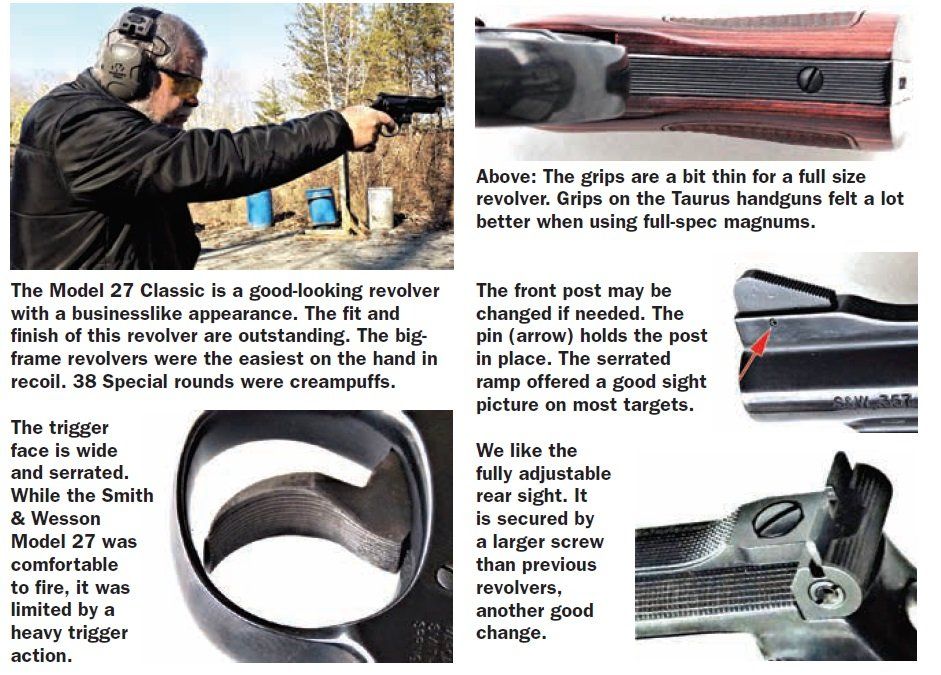
When our FFL logged the gun in, he opened the cylinder and wrote the serial number down in his log book. The serial number was covered with corrosion. Bluing salts left over, or poor storage? We have no idea, and although he offered to send it back, we kept the Model 27. A small amount of rust in this spot doesn’t affect function, and otherwise, the revolver was perfectly acceptable in appearance. We carefully removed the small flecks of rust with a dental pick.
We were surprised, in a negative way, when we tried the double-action trigger. We have tried several modern L-frame revolvers and found good, smooth trigger actions. The Model 27 featured the heaviest double-action trigger action of any Smith & Wesson revolver we can recall. We estimated 20 pounds — it was off the scale of our trigger gauges. The single-action press felt very good, but was also heavy at 6 pounds even. We dry-fired the Smith & Wesson 100 times, and, frankly, it was tiring. There were no hard spots or gritty movement, simply weight. We placed lubricant in the action and dry fired in relays to the tune of 250 cycles. The revolver still did not smooth with use.
The revolvers were fired for combat accuracy first. Notably, the Smith & Wesson could be fully loaded eight times from a box of 50 cartridges with two left over, the Taurus M66, seven times with one left over, and the Taurus 608, six times with two left over. We used the Black Hills Ammunition 38 Special 158-grain rounds first, firing 50 rounds, and the Remington 158-grain lead SWC 357 Magnum 50 rounds as well. Velocity of the 38 Special load was 770 fps, and 1215 fps average for the Magnum load.
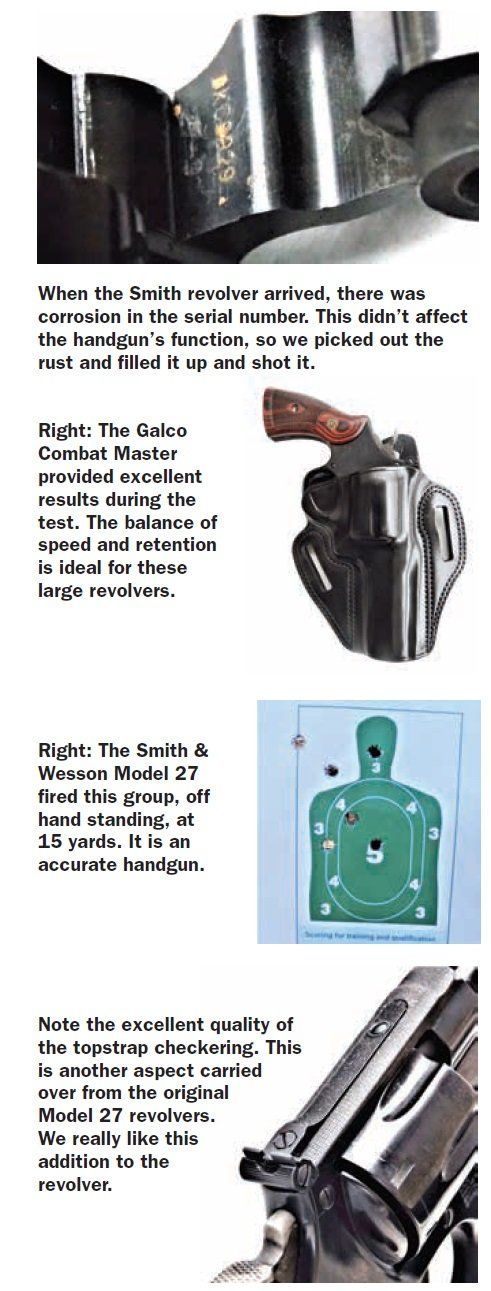
We found the Model 27 was comfortable to fire. The sights made for good accuracy. However, the heavy trigger action demanded a lot of effort, and firing at 5, 7, and 10 yards, it was a challenge to work up real speed. If we sped up, accuracy suffered. When firing the Magnum load, we found the thin grips were uncomfortable. The revolver squirmed in the hand despite the front strap stippling. The movement was due to the leverage of the barrel moving up during recoil. We did not get scraped or nicked, but we had some metal contact with the hand.
We fired for accuracy at 25 yards from a benchrest position. We used the Remington 38 Special 158-grain RNL Wheelgun, the Hornady 125-grain XTP 357 Magnum, and the Black Hills Ammunition 158-grain JHP. Accuracy results were excellent. Each of the Magnum loads exhibited loads as small as 1.25 inches for five-shot groups at 25 yards. The mild 38 Special felt as if it were generating no recoil at all and was more than accurate enough for practice with a 1.8-inch group average. This is excellent accuracy. As one of the raters noted, the Model 27 is comparable to his long-serving Colt Python in accuracy terms.
The problem was in double-action fire, with the heavy trigger action creating a considerable problem. We oiled the action and dry-fired it an additional 500 times, attempting to burnish the action surfaces — special treatment the other revolvers did not get and did not need — and there was no improvement.
Our Team Said: Despite the trigger action’s heavy pull, we really like the Model 27. Fit, finish, and accuracy are excellent. We rated the Model 27 down a full grade based on the trigger action and another half grade based on the grips, which were not the best suited for firing Magnum loads.
Taurus Model 66 2-660041 38 Special/357 Magnum, $371
GUN TESTS GRADE: A
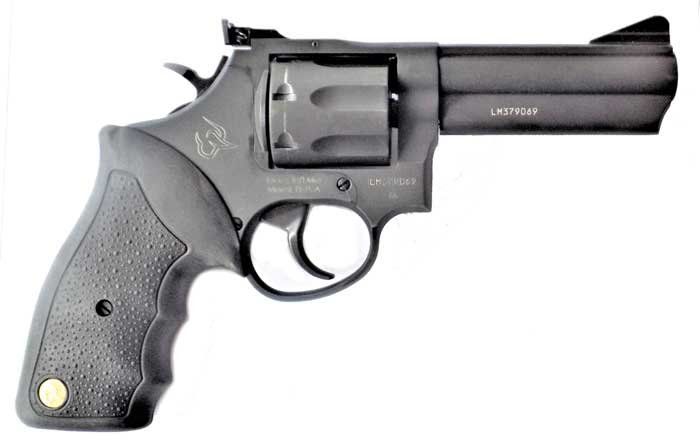
A capable performer. The only medium-frame revolver tested, the Model 66 is well suited to personal defense and home defense, and would make a good field gun for protection against animals. It is suitable for concealed carry with proper load selection.
Action |
Single/Double Action |
Overall Length |
8.8 in. |
Overall Height |
10.5 in. |
Maximum Width (Cylinder) |
1.4 in. |
Weight Unloaded |
38.0 oz. |
Weight Loaded |
41.0 oz. |
Barrel Length |
4.0 in. |
Capacity |
7 |
Frame |
Carbon steel, medium |
Cylinder Material |
Steel |
Front Strap Height |
3.0 in. |
Rear Strap Height |
4.5 in. |
Grips |
Rubber, pebbled |
Grip Thickness (Max) |
1.1 in. |
Grip Circumference (Max) |
5.0 in. |
Front Sight |
Fixed post |
Rear Sight |
Adjustable |
Sight Radius |
6.0 in. |
Trigger Pull Weight Single Action |
6.0 lbs. |
Trigger Pull Weight Double Action |
10.25 lbs. |
Trigger Span Single Action |
3.15 in. |
Trigger Span Double Action |
3.5 in. |
Safety |
Transfer bar |
Warranty |
Lifetime |
Telephone |
(800) 327-3776 |
Website |
TaurusUSA.com |
Made In |
Brazil |
This came from BudsGunShop.com. The Taurus 66 is the least expensive and the lightest revolver tested. Taurus has performed a neat engineering job by shoehorning seven chambers into a K-frame size revolver. The modification comes off well. Compared to six-shot revolvers, we feel that the seven-shot revolver cycles more quickly with a shorter stroke, although all shooters do not seem to be able to discern the added speed. The Taurus features an adjustable rear sight and post front sight. We did not find the clicks as positive as the Smith & Wesson’s, but the Taurus rear sight worked fine for zeroing the pistol.
The hammer spur is checkered, and the wide trigger is smooth and ideal for double-action fire. The double-action trigger is smooth enough, and the single-action trigger breaks at 5.0 pounds after a bit of take up. The hammer houses the Taurus locking system. We did not use it and feel that some will find it useful — it is a sign of the times.
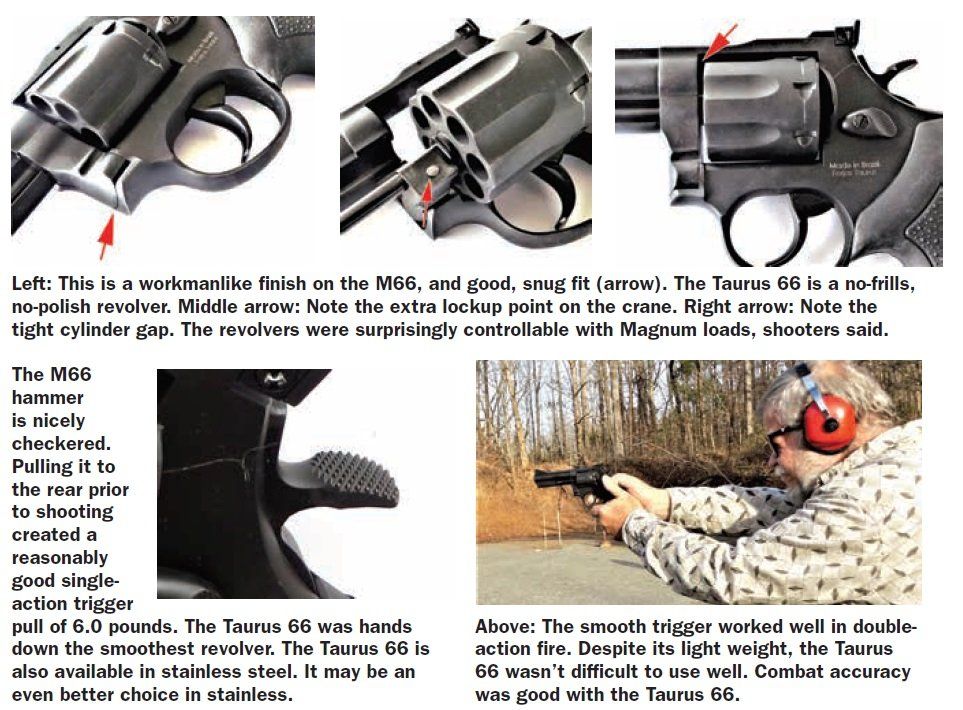
The revolver is supplied in a cardboard box with two keys for the locking system and a neat plastic sight cover to prevent damage to the adjustable sights as they are stored. The finish is a dark-matte-grey color. It isn’t showy, but it works okay.

The grips are nicely pebbled and fill in the space behind the trigger guard. There are slight finger grooves. We rated these grips as a great advantage for the Taurus. They are a superior design, even compared to the Ribber grips found on the Taurus Tracker revolvers we have also tested. The Taurus features an underlugged barrel. Another advantage is an additional locking point on the crane, consisting of a detent that aids in keeping the revolver locked tightly. We dry-fired the revolver prior to the combat test. It isn’t the smoothest double-action trigger we have used, but the smooth trigger face was comfortable to use going back and forth.
During the combat firing stage, the Taurus 66 turned in the best showing. Speed from leather and speed to an accurate first shot hit was good with the M66, the lightest revolver tested. Muzzle blast with the magnum load was there, and the barrel rose considerably, but the rubber grips made the chore of controlling the revolver comfortable. We had one flub; a rater could not close the cylinder. The cylinder release had not returned to its original position after the rater hit the release to reload. At least that may be what happened. The rater also thought he perhaps mishandled the reload as the malfunction did not repeat.
The heavier 608 had an advantage in prolonged fire with magnum loads, like what might be experienced in a bowling pin competition. In accuracy testing the M66, the lightest gun tested, bucked and roared in recoil. But all the 357 Magnum loads generated this type of jolt in all three revolvers. The Taurus 66 simply moved the most in recoil due to its weight. We did not have to move our hand or reposition our grip to control the handgun.
Our Team Said: For personal defense, the Model 66 7-shooter was the top pick from this trio, our shooters said. The Taurus grips made recoil bearable and controllable. Bench accuracy at 2.2 to 2.5 inches was not as good as the Smith & Wesson Model 27 or its Taurus 608 stablemate, but that level of accuracy is acceptable for a personal-defense firearm. But, overall, we preferred the Taurus M66 for most tasks.
Taurus 608 2-608049 38 Special/357 Magnum $548
GUN TESTS GRADE: A-
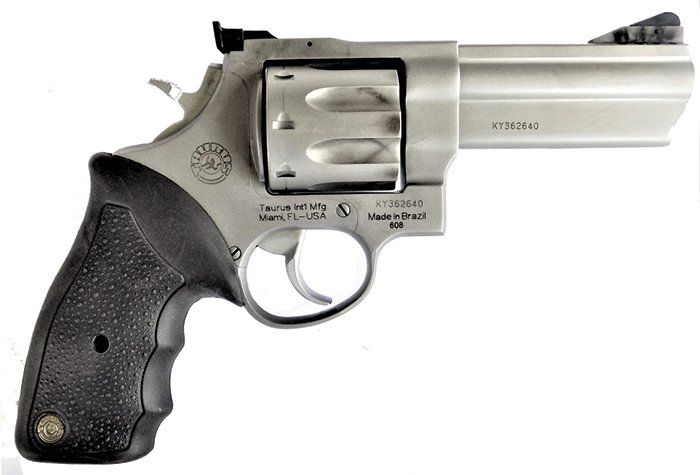
The Taurus 608 is a good performer. It wasn’t the most accurate revolver, but it is more than accurate enough for hunting or any reasonable chore. The action is smooth enough. It is a big gun. Just the same, the size and eight-shot capacity made it ideal for home defense.
Action |
Single/Double Action |
Overall Length |
9.4 in. |
Overall Height |
6.0 in. |
Maximum Width (Cylinder) |
1.77 in. |
Weight Unloaded |
44.0 oz. |
Weight Loaded |
47.1 oz. |
Barrel |
4.0 in. stainless steel, compensated |
Capacity |
8 |
Frame |
Matte stainless steel, large frame |
Cylinder Material |
Matte stainless steel |
Front Strap Height |
3.0 in. |
Rear Strap Height |
4.5 in. |
Grips |
Rubber, pebbled |
Grip Thickness (Max) |
1.1 in. |
Grip Circumference (Max) |
5.4 in. |
Front Sight |
Fixed post with red insert |
Rear Sight |
Adjustable |
Sight Radius |
5.75 in. |
Trigger Pull Weight Double Action |
11.0 lbs. |
Trigger Pull Weight Single Action |
6.0 lbs. |
Trigger Span Single Action |
2.7 in. |
Trigger Span Double Action |
3.5 in. |
Safety |
Transfer bar |
Warranty |
Lifetime |
Telephone |
(800) 327-3776 |
Website |
TaurusUSA.com |
Made In |
Brazil |
This also came from BudsGunShop.com. The 608 is much more expensive than the M66 and is also more difficult to locate. It isn’t likely to be found on the shelf, per our experience in attempting to locate an example. We went through several distributors before securing the 608.
What we have is a stainless-steel large-frame revolver with a 4-inch barrel and 8-shot cylinder. The Taurus 608 features the same Taurus action lock and transfer bar ignition as the M66, and the same crane lock up. This detent in the crane adds to rigidity as the revolver is fired. The 608 features a heavy underlugged barrel.
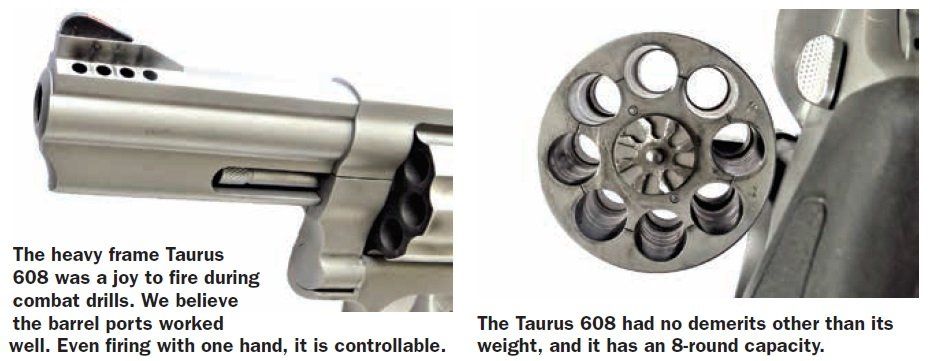
There are improvements over both the Taurus 66 and the Smith & Wesson M27. The front sight features a red insert that aids in quickly getting a sight picture. Stainless construction is a plus for carry and outdoors work. The revolver also features eight barrel ports, four on each side of the front sight. We did not find these ports offensive in muzzle blast. Velocity wasn’t cut by these ports; in fact the M608, exhibited the highest velocity of the three revolvers by 40 to 70 fps with magnum loads. We really liked the grip design. The grip is practically the same size as the smaller-frame M66 revolver and is much more comfortable than the Smith & Wesson Model 27, in our view. The double-action trigger is smooth enough. The single-action press breaks at 5.0 pounds. One of the raters noted that the bolt-stop cuts on the M66 seven-shooter are cut in the metal between the cylinders, while the eight-shot 608 has bolt stops cut directly over the cylinders. Some may be concerned about the metal thickness between the cylinders and the cuts, but we feel that this is a theoretical concern, at best, with factory loads.
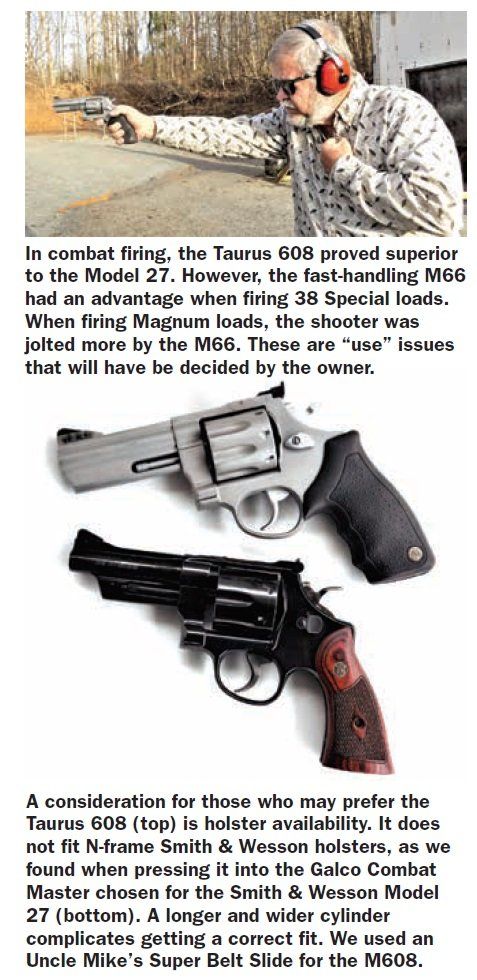
Firing for combat groups, the M608 wasn’t as fast from leather as the M66, but it tied with the M27 revolver for speed. Speed to a first shot hit was aided by the red-insert front sight.
The Taurus stays on the target as it is fired and is comfortable in recoil, due to its weight and the efficient Taurus grips. In combat firing, the Taurus 608 proved superior to the Model 27 by a margin. However, the fast-handling M66 had an advantage when firing 38 Special loads. When firing Magnum loads, the shooter was jolted more by the M66. The M66 was faster to the all-important first-shot hit. The M608 provided better combat groups by a margin with magnum loads compared to the Smith & Wesson or the smaller Taurus M66. Absolute accuracy was another matter. In this phase of testing, the M608 was the most comfortable revolver to fire, again because of the greater weight compared to the M66 and superior grips compared to the M27. Fired for bench accuracy, the M608 proved more accurate than the M66, with some groups as small as 1.8 inches.
Our Team Said: The M608 provided good performance for the price. We carefully weighed the performance against the price and found the 608’s stainless construction, efficient barrel ports, red insert front sight, and extra round advantages over the Taurus M66. However, it is also heavier and more difficult to conceal. Only the owner may answer if the extra features are worth an extra $200. We think the M66 could be a concealed-carry gun that doubles as a house gun. We would choose the Taurus 608 as a field gun that doubles as a house gun.

























